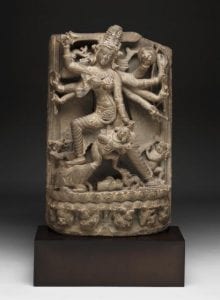This sculpture of the Hindu goddess Shri Devi in her form known as Durga. In this sculpture Durga is known as the “destroyer of the buffalo demon”. The name of the demon is Mahishasura. Mahishasura was born from a she-buffalo and the King of the Asura’s Rambha. Mahishasura succeeded his father and at the time of this story is King of the Asuras. Mahishasura wants to defeat the Devas in battle so he goes to the mountains to pray to Brahma for the help. Initially, Mahishasura asks for immortality but Brahma tells him this is an impossible request. So Mahishasura asks Brahma for the power to not be killed by neither man nor God. Brahma agrees and Mahishasura was granted invulnerability from both men and gods. Brahma gives Mahishasura this power because of Mahishasura’s prayers to him. This is important to the story because asuras and devas, or gods, were in a perpetual fight. So, after receiving this gift, Mahishasura goes on a rampage through both heaven and earth that resulted in him conquering both realms and the devas having to retreat into the mountains. Once there, the deities combine their powers and give them to Durga. Durga, wielding the weapons of the gods, goes to battle against Mahishasura riding a lion. Durga cuts off the head of the buffalo demon and kills Mahishasura with her mighty sword. Durga can do this because she is neither man nor god, but a goddess.
This victory over Mahishasura is celebrated in parts of eastern India with a ten day festival held during the seventh month of the Hindu calendar. This festival coincides with Navrati, a nine-night festival that celebrates the Devi. The celebration concludes on with Vijaya Dashami, or the Tenth Day of Victory. This day is celebrated with loud chants and drums as well as idols of the Goddess are sent to the river to be submerged so that she may be with her husband, Shiva.
This sculpture dates back to the 12th century and most likely comes from the Bengal or Assam regions of India, as that is where Shaktism is most popular. Shaktism itself is a sect of Hinduism that believes the universe is feminine and believes Devi are the supreme divinity. Those who practice Shaktism worship the many forms of Devi, ranging from Durga, Kali, Shitala and more. This form of Hinduism saw it’s first glimpses roughly around 20,000 BCE. Proof of this is Harappan goddess figurines as well as triangular stones that are similar to stones used in worship today. During the Vedic age worship of Goddesses was prominent but they were seen as subordinates to the male deities. but spread during the Gupta Age spanning from 3rd to 7th centuries. An important text in Shaktism is the Devi Mahatmya, which was composed in the 5th or 6th century. This is the document that marks the distinction of Shaktism as a separate denomination.
 Shakti teachings are seen as complementary to Shaivism teachings, as Shiva represents the male and Shakti represents the female. Shakti doctrines focus on the difference between physical matter and spirit.
Shakti teachings are seen as complementary to Shaivism teachings, as Shiva represents the male and Shakti represents the female. Shakti doctrines focus on the difference between physical matter and spirit.

